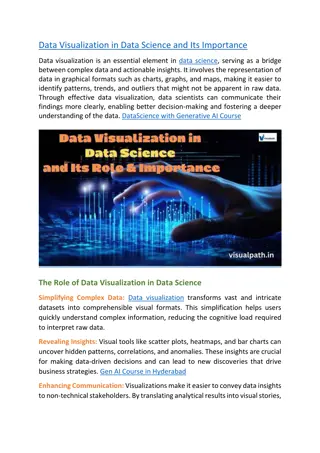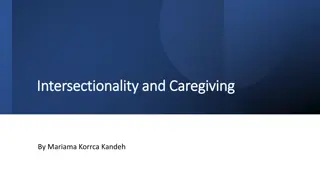Understanding Intersectionality in AI: Analyzing Biases in Generative Systems
Machine learning in AI can perpetuate biases related to race and gender. This workshop explores the concept of intersectionality to analyze how AI-generated avatars represent identities based on race, gender, and ethnicity. Participants will learn to recognize biases in generative AI and develop critical thinking skills to address ethical concerns in practical AI applications.
Download Presentation

Please find below an Image/Link to download the presentation.
The content on the website is provided AS IS for your information and personal use only. It may not be sold, licensed, or shared on other websites without obtaining consent from the author. Download presentation by click this link. If you encounter any issues during the download, it is possible that the publisher has removed the file from their server.
E N D
Presentation Transcript
Generative AI: a problematic illustration of the intersections of racialized gender, race and ethnicity Workshop design: Nayiri Keshishi (University of Surrey) Workshop content: repurposed, with full author permission, from this blog by Dustin Hosseini (University of Glasgow)
Workshop feedback & licensing We d like to gather your views on this workshop, via this online survey, from both student participants and educators. This should take no longer than 5-10 minutes to complete. You can scan the QR code or use the link below. This survey has received full ethical clearance from the University of Surrey. This work is licensed under the Creative Commons Attribution-NonCommercial 4.0 International License. To view a copy of this license, visit http://creativecommons.org/licenses/by- nc/4.0/ or send a letter to Creative Commons, PO Box 1866, Mountain View, CA 94042, USA. Thank you for taking the time to participate in this research! https://forms.gle/9wbx1ye1P3d eLRrB7
Learning outcomes Recognise and understand biases in generative AI, particularly regarding race and gender. Develop critical and analytical thinking to make ethical choices and address biases in practical AI applications. Communicate the ethical complexities of AI's impact on race and gender, promoting awareness towards ethical considerations and solutions.
Intro Machine learning allows AI to become more intelligent by drawing on datasets ? develop expertise over time Rely on raw data created by humans ? reflect biases e.g. racial, economic of those who have gathered the evidence (Benjamin, 2019) Research is looking into the reasons that enable AI to skew results and create representations that overlook and erase others, whilst focusing on specific, dominant groups (Noble, 2018; Benjamin, 2019; Mohamed et al., 2020; Zembylas, 2023) The way human-created algorithms inform AI to portray racialized, gendered people is especially problematic. To understand this, it is worth looking at the ideas of intersectionality (Crenshaw, 1991; hooks, 2015; Hill Collins, 2019).
What is intersectionality? The concept of intersectionality describes the ways in which systems of inequality based on gender, race, ethnicity, sexual orientation, gender identity, disability, class and other forms of discrimination intersect to create unique dynamics and effects (Center for Intersectional Justice, 2023) Will use this concept to analyze AI-generated avatars, looking at how they represent socially constructed identities in terms of racialized gender, race, ethnicity and nationality. What is represented and why the representations might appear this way?
Common generative AI tools For now, three or four major types: 1. text to text (e.g. ChatGPT, Google Bard) 1. text to image (e.g. DALL-E) 1. text to media, such as audio or video 1. text-to-code, for coding and programming purposes
To note Ethnicity = the culture, nationality, ancestry and/or language shared by a group of people irrespective of their physical appearance Race = group of people that share some socially defined characteristics, for instance, skin colour, hair texture, or facial features We will use definitions of race and ethnicity offered by Fitzgerald (2020, p. 12)
Another definition of race informed by decolonial thinking: A dividing line that cuts across multiple power relations such as class, sexual and gender at a global scale (Grosfoguel, 2016, p. 11) The above implies race and subsequent racism are institutional and structural in nature ? the concept of race creates hierarchies of power and domination which are compounded by gender, sex, class and other factors. While the concepts of race and ethnicity are social constructs and neither are mutually exclusive, we will use these definitions to frame our analysis. NB: You may find the results upsetting and potentially angering.
Sweet old grannies making pancakes why? Wide discussions on the issues of generative AI and how to prepare students and educators I like pancakes! Grandmothers play a significant role in several cultures E.g. in Russia, they are a major cultural symbol and source of unpaid family work (Utrata, 2008) and symbol of stoicism that represents an intersection of age, gender and class (Shadrina, 2022).
Acknowledgments Using gendered, ageist and even stereotypical language, especially in terms of describing 'a sweet, old X grandmother . Focused on a particular type of social/familial role Not all old(er) women are grandmothers and not all grandmothers are old Adjectives used to describe 'opinion, size, age, shape, colour, origin, material, purpose' often translate to gender, race, racism and racialization, and the humanity of individuals and groups of individuals (Benjamin, 2019, p.102; Dowling, 2016; Wynter, 2003).
Initial prompts "Create an image of a sweet, old Polish grandmother making pancakes" "Create an image of a sweet, old Russian grandmother making pancakes" "Create an image of a sweet, old American grandmother making pancakes" "Create an image of a sweet, old Black American grandmother making pancakes"
Representations of Polish grandmothers
Representations of Russian grandmothers
Representations of American grandmothers
Representations of grandmothers from the US racialized as Black
Representations of grandmothers from the US racialized as Black Representations of Polish grandmothers Representations of Russian grandmothers Representations of American grandmothers
Description Describes/outlines/summarises/defines a theory, a viewpoint or a situation What? When? Who? Where? Provides context (background) to a subject = Tells or restates Analysis & Evaluation Compares/explores/assesses strengths and weaknesses (to understand complexity and depth) Why? How? Provides reasons and draws informed conclusions So what? What next? = Comments, makes links and shows implications How do you know? Scholarly support
Atmosphere, decor, clothing Expressions and ethnicity Description Analysis (what might it mean?) Evaluation (what do you know?) Description Analysis (what might it mean?) Evaluation (what do you know?) Representations of Polish and Russian grandmothers Representations of grandmothers from the US Representations of grandmothers from the US racialized as Black
Questions Why do the avatars represent these groups in the way that they do? What informs how the avatars construct the representations? What, if anything, do the representations get right? What, if anything, do the illustrations get wrong? How are the representations problematic? Where representations are problematic... o What message does this send to someone without knowledge of the context? o What message does this create about the people/cultures/objects portrayed in the images? o What can you do to ensure generative AI creates, if it is possible, more accurate and equitable representations of peoples/cultures/objects?
Discussion Each image represents deeply ingrained cultural prejudices and biases (Benjamin, 2019, p.59) drawn from data that the generative AI tools use to create representations Algorithmic coloniality ? (Mohamed et al., 2020; Zembylas, 2023). Coloniality = state of knowing and being that encompasses knowledge and power relations that sees those formerly colonized and/or enslaved as encountering inherent disadvantages whilst former colonizers keep many advantages (Quijano and Ennis, 2000; Wynter, 2003; Ndlovu-Gatsheni, 2015). In simple terms ? accepted knowledges and ways of being represent those of the dominant members of society
Discussion ctd Those who follow the dominant modes of cultural, and technological production, take part in the creation and preservation of algorithms which overvalue some humans (those racialized as White) whilst undervaluing the humanity of other humans (those racialized as Black, Asian and others). Considering the daily injustices that people racialized as Black, Asian and others experience, it is problematic that human- authored algorithms reflect dominant systems of knowing and being Influence the datasets that inform algorithms ? allow for some change? Not easy Collaboration and awareness of everyone on the issues will be key Might include understanding and identifying such sites (where and how algorithms are made/ function), who is involved in beta-testing and testing generally, and what local/ national policies can be developed. Also includes developing algorithmic literacy as part of digital literacy initiatives (Zembylas, 2023; Mohamed et al., 2020, p. 8).
Conclusion We must experiment with generative AI tools to understand and critique the tools and what they produce Begin to understand how and why such tools create the content that they do No concrete solution ? collective and concentrated effort that includes a range of groups focused on creating a more equitable and inclusive world Decolonial thinking can offer some thoughts to counter the coloniality of AI
References Benjamin, R. (2019). Race After Technology: Abolitionist Tools for the New Jim Code. Polity Press. Bowdre, K. M. (2006). Racial mythologies: African American female images and *representation from minstrelsy to the studio era. [Doctoral dissertation/thesis, University of Southern California]. Center for Intersectional Justice (2023) What is Intersectionality. Available at https://www.intersectionaljustice.org/what-is-intersectionality (Accessed: 28 Sept 2023). Crenshaw, K. (1991). Mapping the Margins: Intersectionality, Identity Politics, and Violence against Women of Color. Stanford Law Review, 43, No. 6, 1241-1299. https://doi.org/10.2307/1229039 Dowling, T. (2016) Order force: the old grammar rule we all obey without realising. Available at: https://www.theguardian.com/commentisfree/2016/sep/13/sentence-order-adjectives-rule-elements-of-eloquence-dictionary (Accessed: 24 July 2023). Downing, C. (2007). Interlocking oppressions of sisterhood: (re) presenting the black woman in nineteenth century blackface minstrelsy . Senior Scholar Papers, Paper 539. https://digitalcommons.colby.edu/seniorscholars/539 Fitzgerald, K. J. (2020). Recognizing Race and Ethnicity: Power, Privilege and Inequality (Third ed.). Routledge. Grosfoguel, R. (2016). What is Racism. Journal of World-Systems Research, 22(1), 9-15. https://doi.org/10.5195/jwsr.2016.609 Hill Collins, P. (2019). Intersectionality as Critical Social Theory. Duke University Press. hooks, b.. (2015). Ain t I a Woman: Black Women and Feminism. Routledge. Hosseini, D. (2023). Generative AI: a problematic illustration of the intersections of racialized gender, race, ethnicity . Dustin Hosseini blog, 8 August. https://www.dustinhosseini.com/blog/2023/08/08/generative-ai-a-problematic-illustration-of-the- intersections-of-racialized-gender-race-ethnicity King, J. E. (2019). Staying Human: Forty Years of Black Studies Practical-Critical Activity in the Spirit of (Aunt) Jemima. International Journal of African Renaissance Studies - Multi-, Inter- and Transdisciplinarity, 14(2), 9-31. https://doi.org/10.1080/18186874.2019.1690399 Mohamed, S., Png, M.-T., & Isaac, W. (2020). Decolonial AI: Decolonial Theory as Sociotechnical Foresight in Artificial Intelligence. Philosophy & Technology, 33(4), 659-684. https://doi.org/10.1007/s13347-020-00405-8 Ndlovu-Gatsheni, S. J. (2015). Decoloniality as the Future of Africa. History Compass, 13(10), 485-496. https://doi.org/10.1111/hic3.12264 Noble, S. U. (2018). Algorithms of Oppression: How Search Engines Reinforce Racism. New York University Press. Quijano, A., & Ennis, M. (2000). Coloniality of Power, Eurocentrism, and Latin America. Nepantla: Views from South, 1(3), 533-580. Shadrina, A. (2022). Enacting the babushka: older Russian women doing age, gender and class by accepting the role of a stoic carer. Ageing and Society, 1-18. https://doi.org/10.1017/s0144686x2200037x Thompson Moore, K. (2021). The Wench: Black Women in the Antebellum Minstrel Show and Popular Culture. The Journal of American Culture, 44(4), 318-335. https://doi.org/10.1111/jacc.13299 Utrata, J. (2008). Babushki as Surrogate Wives: How Single Mothers and Grandmothers Negotiate the Division of Labor in Russia. UC Berkeley: Berkeley Program in Soviet and Post-Soviet Studies. https://escholarship.org/uc/item/3b18d2p8 Wallace-Sanders, K. (2008). Mammy: A century of race, gender, and southern memory. University of Michigan Press. Wynter, S. (2003). Unsettling the Coloniality of Being/Power/Truth/Freedom: Towards the Human, After Man, Its Overrepresentation An Argument. CR: The New Centennial Review, 3(3), 257-337. https://doi.org/10.2307/41949874 Zembylas, M. (2023). A decolonial approach to AI in higher education teaching and learning: strategies for undoing the ethics of digital neocolonialism. Learning, Media and Technology, 48(1), 25-37. https://doi.org/10.1080/17439884.2021.2010094
Feedback We now wish to gather feedback, via this online survey, from both student participants and educators delivering the workshop. This should take no longer than 5-10 minutes to complete. Thank you for taking the time to participate in this research! https://forms.gle/9wbx1ye1P3deLRrB7
This work is licensed under the Creative Commons Attribution-NonCommercial 4.0 International License. To view a copy of this license, visit http://creativecommons.org/licenses/by-nc/4.0/ or send a letter to Creative Commons, PO Box 1866, Mountain View, CA 94042, USA.























